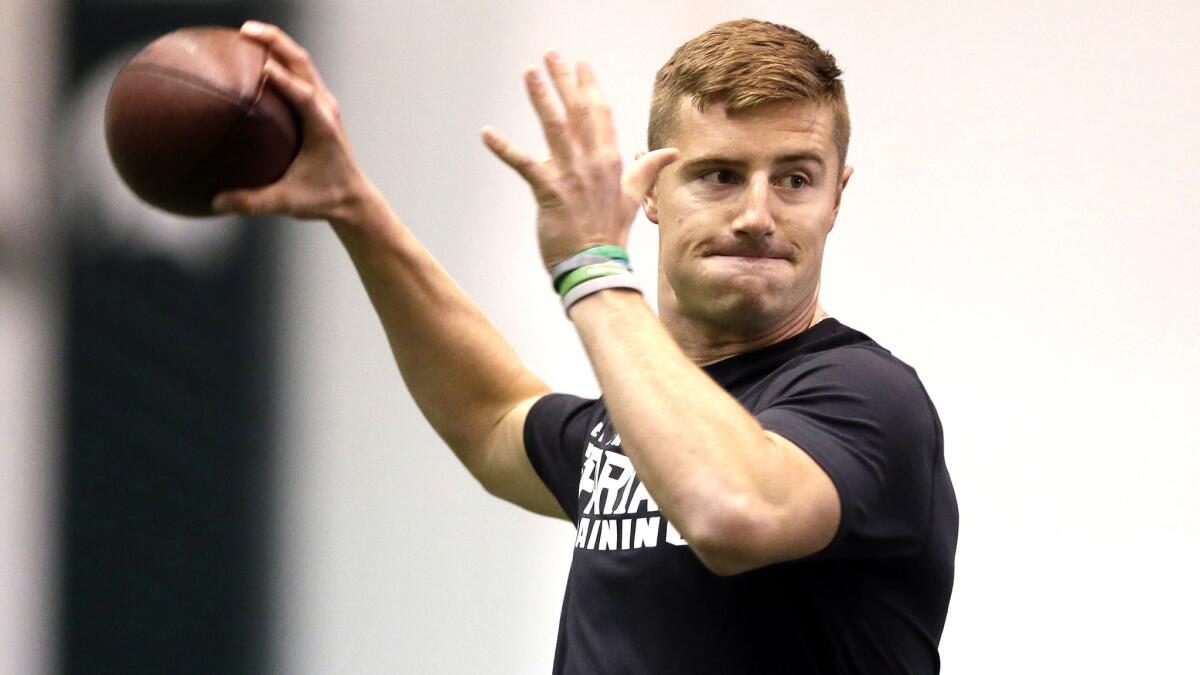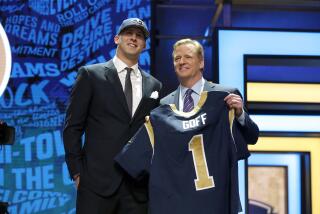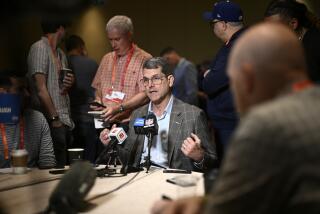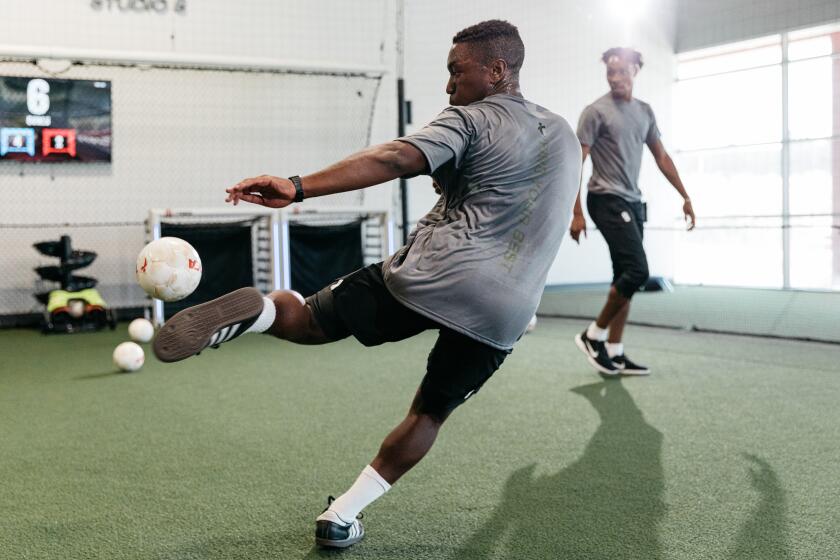Column: NFL draft reiterates the importance of the quarterback position

Quarterback Connor Cook throws during a drill for NFL scouts at Michigan State’s pro day last month.
Many will remember this NFL draft as the year California’s Jared Goff went first and North Dakota State’s Carson Wentz second, the third time in five drafts that the event kicked off with quarterbacks going 1-2.
Just as intriguing, though, were the quarterback story lines later in the draft, when Oakland got a bargain-basement deal on Michigan State’s Connor Cook, Dallas — twice rebuffed in targeting passers — finally zeroed in on someone who could eventually replace Tony Romo, and both New England and Buffalo found interesting projects to develop.
If this off-season has demonstrated anything, it’s that quarterbacks are at a premium, and clubs often have to go to great lengths to get them. That’s why Houston is paying the lightly experienced Brock Osweiler $18 million per season, and why the Rams and Philadelphia traded away a boatload of picks to move into position to pick Goff and Wentz.
Dallas and Denver were both interested in Memphis quarterback Paxton Lynch, and talked with Seattle about trading into the 26 spot to get him. The Seahawks worked a deal with the Broncos, thereby ensuring Seattle wouldn’t have to trade entirely out of the first round. That was strike one for the Cowboys.
On Saturday, they had hoped to get the free-falling Cook in the fourth round. Instead, Oakland sneaked just ahead of them by virtue of a trade with Cleveland, and made Cook the second pick of the day (No. 100). Strike two for Dallas. It marked the first time in Reggie McKenzie’s five years as Raiders general manager that he traded up during the draft to get a player.
The Cowboys ultimately took Mississippi State quarterback Dak Prescott later in the fourth (No. 135), just the second quarterback they have drafted since 2007. (By comparison, they have selected as many kickers during that span.) It’s not as if they plucked Prescott’s name out of a hat. They visited him on campus, and brought him in for a visit. Ideally for them, he will learn and develop behind Romo until the eventual torch passing.
In 2015, the Cowboys got a painful reminder of the importance of the position. Romo was sidelined 12 games because of injuries last season, and his team went 1-11 in those. It’s time to lay the groundwork for the path forward.
Whereas Romo just turned 36, the Raiders have a 25-year-old franchise quarterback in Derek Carr, a second-round pick just two years ago. So why did they take Cook? First, he was a great value in the fourth round, slipping in part because there were questions about whether he was fully embraced by his college teammates. But McKenzie is good about taking the long view, as opposed to drafting for immediate need. The Raiders could have taken a running back — they wound up taking one a round later — but they opted for an insurance policy at the most important position.
Remember, a lot of people questioned why Washington would use a fourth-round pick on another Michigan State quarterback, Kirk Cousins, in the same draft they took Robert Griffin III second overall. In retrospect, that was a smart move, as Cousins is the offensive centerpiece of that franchise.
Three AFC East teams drafted quarterbacks, with the New York Jets taking Penn State’s Christian Hackenberg in the second, the Patriots selecting North Carolina State’s Jacoby Brissett in the third, and Buffalo going with Ohio State’s Cardale Jones in the fourth.
Even with the stability of Tom Brady, the Patriots under Coach Bill Belichick have never gone more than two consecutive drafts without taking a quarterback. So it wasn’t surprising they grabbed Brissett, although it’s notable they used a relatively early pick on a quarterback just two years after using a second-rounder on Jimmy Garoppolo.
If the rookie pans out, the Patriots would have the luxury of trading Garoppolo after this season and having Brissett step into his backup role. Of course, Garoppolo is vital this year, with Brady suspended for the first four games of the season.
The Bills have a starter in Tyrod Taylor, and a backup in EJ Manuel, so they will have time to develop Jones, who has a big arm and can run. Their ability to hang on to Taylor after this season hinges on signing him to a long-term deal. They have only one franchise-player designation and could have to make a choice among one of three players: Taylor, cornerback Stephon Gilmore, and left tackle Cordy Glenn. In other words, Jones, when developed, gives them options.
Cleveland raised some eyebrows Friday by taking USC’s Cody Kessler in the third round. Several scouts around the league thought that was a reach for a player who, although accurate, didn’t bowl them over with his arm, mobility, or ability to make quick decisions.
“I understand where everybody’s coming from, but you’ve got to trust me on this one,” new Browns Coach Hue Jackson told reporters. “This is a guy that we feel very comfortable with, and we feel he’s going to have an opportunity to ascend.”
The Browns have cycled through 24 starting quarterbacks since relaunching as an expansion franchise in 1999. Opportunity isn’t the problem. The key is actually finding the answer.
sam.farmer@latimes.com
Twitter: @LATimesfarmer
More to Read
Get our high school sports newsletter
Prep Rally is devoted to the SoCal high school sports experience, bringing you scores, stories and a behind-the-scenes look at what makes prep sports so popular.
You may occasionally receive promotional content from the Los Angeles Times.







